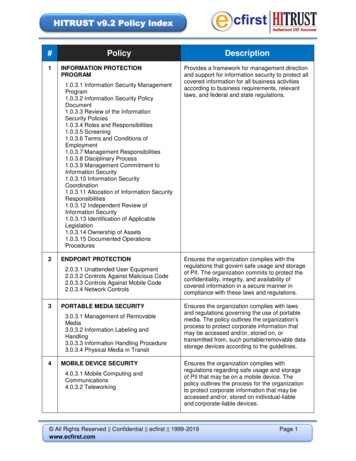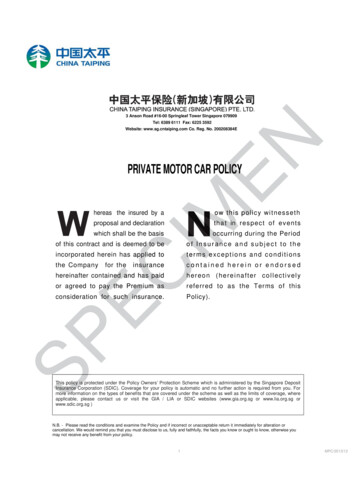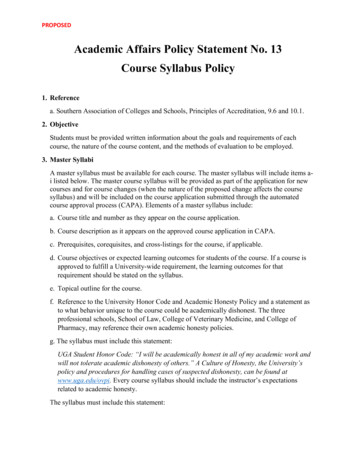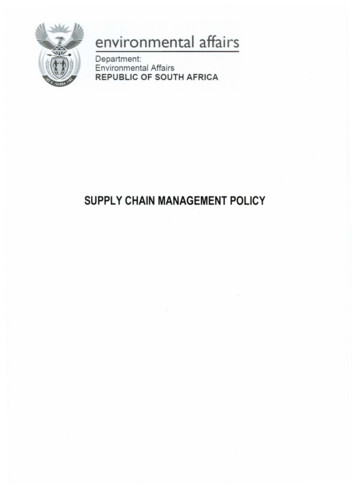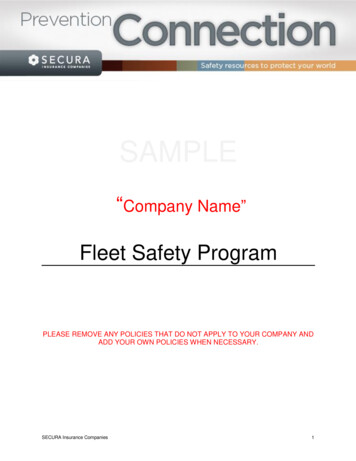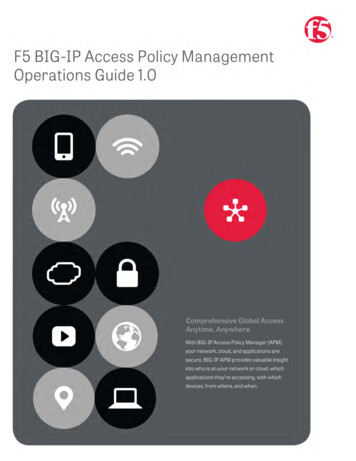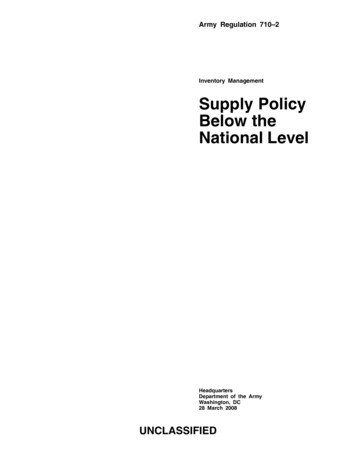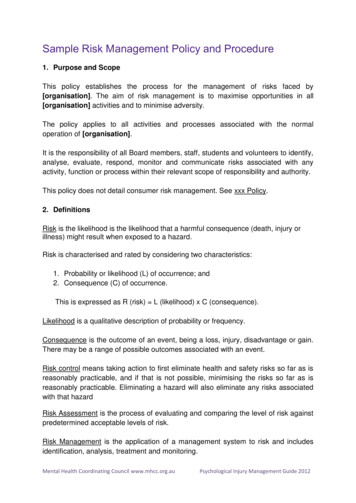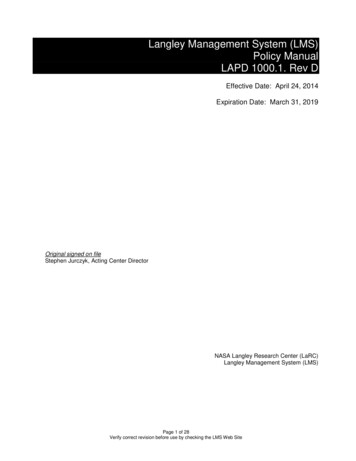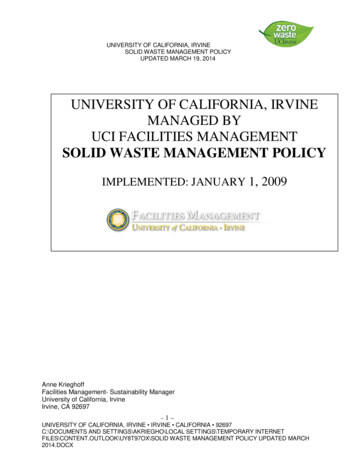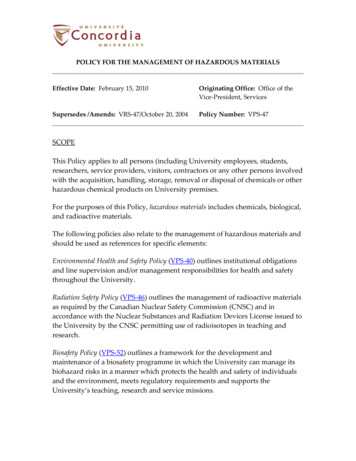
Transcription
POLICY FOR THE MANAGEMENT OF HAZARDOUS MATERIALSEffective Date: February 15, 2010Originating Office: Office of theVice-President, ServicesSupersedes /Amends: VRS-47/October 20, 2004Policy Number: VPS-47SCOPEThis Policy applies to all persons (including University employees, students,researchers, service providers, visitors, contractors or any other persons involvedwith the acquisition, handling, storage, removal or disposal of chemicals or otherhazardous chemical products on University premises.For the purposes of this Policy, hazardous materials includes chemicals, biological,and radioactive materials.The following policies also relate to the management of hazardous materials andshould be used as references for specific elements:Environmental Health and Safety Policy (VPS-40) outlines institutional obligationsand line supervision and/or management responsibilities for health and safetythroughout the University.Radiation Safety Policy (VPS-46) outlines the management of radioactive materialsas required by the Canadian Nuclear Safety Commission (CNSC) and inaccordance with the Nuclear Substances and Radiation Devices License issued tothe University by the CNSC permitting use of radioisotopes in teaching andresearch.Biosafety Policy (VPS-52) outlines a framework for the development andmaintenance of a biosafety programme in which the University can manage itsbiohazard risks in a manner which protects the health and safety of individualsand the environment, meets regulatory requirements and supports theUniversity’s teaching, research and service missions.
POLICY FOR THE MANAGEMENT OF HAZARDOUS MATERIALSPage 2 of 13PURPOSEThe purpose of this Policy is to establish a framework whereby the Universitycan manage its hazardous materials in a responsible manner while maintainingits teaching, research and service missions. To this end, the University iscommitted to ensuring that individuals using hazardous materials are regularlyinformed about risks, trained in safe handling procedures and adequatelysupervised. The University is also committed to encouraging reduction in theacquisition of hazardous materials, the recycling of such materials andsubstitution for less toxic materials wherever feasible.The University shall establish and maintain a Hazardous Materials ManagementProgramme which supports the teaching, research and service functions of theUniversity. It will comply with all federal, provincial and municipal legislationconcerning occupational health and safety and the environment, and willconform to recognized codes and standards of practice.For a glossary of terms and acronyms used in this Policy, refer to Appendix A.POLICYGeneral1.The University recognizes its responsibility to act with due diligencewhere hazardous materials are concerned.2.The University shall establish a University Hazardous MaterialsCommittee (UHMC) of academic and technical experts to advise theUniversity community on practices related purchasing, handling, storageand disposal of hazardous materials, and compliance with legislation.3.The University is responsible for the safe handling and disposal ofhazardous waste (including transport as per TDG regulations) from the
POLICY FOR THE MANAGEMENT OF HAZARDOUS MATERIALSPage 3 of 13point of generation to final treatment and disposal, and shall maintain anemergency response policy and procedure manuals.4.Purchasing and acquisitions of hazardous materials shall be done only byindividuals with appropriate training.5.An inventory of hazardous materials shall be maintained and verified atleast annually.6.Hazardous materials shall be ordered only in quantities required and shallbe stored in appropriate areas in accordance with University guidelinesfor hazardous materials storage, taking into consideration theirflammability, corrosive properties, toxicity and reactivity.7.Hazardous materials shall be labeled in accordance with federal andprovincial regulations. Material safety data sheets must be accessible inthe area where hazardous materials are used.8.Hazardous materials shall only be used in facilities which have beendesignated for their use and are appropriately and adequately equippedto control personnel exposure and minimize risk.9.Personal protective equipment shall be worn wherever it is required.10.Appropriate antidotes and spill response materials shall be kept in closeproximity to locations where hazardous materials are used.11.Individuals using hazardous materials shall be appropriately trained andadequately supervised.12.All individuals who use, handle or store hazardous materials shall receiveWHMIS training.
POLICY FOR THE MANAGEMENT OF HAZARDOUS MATERIALSPage 4 of 1313.An inventory of hazardous materials shall be maintained both in thedepartment and in a central University registry which shall be accessibleto emergency responders as required.14.Written procedures and guidance documents relating to hazardousmaterials management shall be produced by the Environmental Healthand Safety Office (EH&S Office) and if specifically required due toparticular activity, by the department or research laboratory. Theseprocedures shall be modified to reflect changes in legislation, Universityoperations and recognized standards or codes of practice.15.Hazardous waste disposal shall conform to federal, provincial andmunicipal legislation, University policies and recognized standards ofpractice.16.Academic and research staff are responsible for closing down theirlaboratory operations and arranging for the disposal of hazardousmaterials upon the completion of their employment contract or relocationof their operations.17.Hazardous materials transferred to other users must be recorded throughthe inventory control system.OPERATIONAL RESPONSIBILITIESThe Environmental Health and Safety Office18.The EH&S Office shall develop, coordinate and oversee the HazardousMaterials Management Programme and provide support to the Universitycommunity and the UHMC in carrying out the duties established therein.To that end, the EH&S Office shall:
POLICY FOR THE MANAGEMENT OF HAZARDOUS MATERIALSPage 5 of 13a.Provide information, support and advice to individuals anddepartments on the management of hazardous materials;b.Assist the Office of Research, researchers and departments inconducting risk assessments and evaluate any special certificationrequirements or needs before issuing certificates as required;c.Support departments and service areas with the maintenance oftheir inventory and oversee the hazardous materials registry;d.Organize and coordinate the hazardous waste managementprogramme in accordance with federal, provincial and municipalregulatory requirements;e.Maintain procedures to respond to hazardous material emergenciesand coordinate response to spills and/or accidental releases of andexposures to hazardous materials;f.Maintain records of accidents and incidents and carry out andparticipate in investigations as required;g.Provide general training sessions on hazardous materialsmanagement: specifically WHMIS/GHS, TDG, Radiation Safety,Biosafety, spill response and waste management, and other topicsas required;h.Monitor the level of WHMIS compliance and report at leastannually to the UHMC and the Central Advisory Health and SafetyCommittee;i.Initiate and participate in facility inspections, with particularattention to storage, handling and disposal of hazardous materials
POLICY FOR THE MANAGEMENT OF HAZARDOUS MATERIALSPage 6 of 13and make recommendations to the appropriate authority forcorrective action;j.Investigate and respond to complaints and inquiries, and reportfindings to the UHMC on a regular basis, the Central AdvisoryHealth and Safety Committee as requested, and the Vice-President,Services, as required;k.Represent the University to external compliance agencies andreport to external compliance agencies as required.l.Monitor legislation concerning hazardous materials and theenvironment, and advise University administrators and the UHMCabout its potential impact on University activities.Office of Research19.The Office of Research shall:a.Notify researchers of the internal EH&S certification requirements;b.Provide EH&S with the list of approved grants that require EH&Scertification;c.Withhold grants that do not receive prior EH&S certification.Deans, Chairs, Research Directors, Department Directors, Managers, Supervisors20.Responsibility for the management of hazardous materials withinadministrative, academic and service units lies with the line supervision inaccordance with the Environmental Health and Safety Policy (VPS-40).
POLICY FOR THE MANAGEMENT OF HAZARDOUS MATERIALSPage 7 of 1321.Safety Officers may be appointed to assist persons or managers at alllevels of the line of supervision in the exercise of these duties.22.In addition, managers at the appropriate level of the line of supervisionmust:a.Ensure that engineering controls e.g. fume hoods, biologicalcabinets and containment or storage devices, emergency shut-offsand safety equipment are adequate, appropriate and in goodworking order and are used when required;b.Ensure that inventories of hazardous materials are up-to-date andavailable to EH&S;c.Provide and maintain all personal protective equipment requiredby personnel and ensure training has been provided in properutilization;d.Maintain the necessary material and equipment for spill response;e.Carry out inspections of laboratories, studios and workshops;f.Cooperate with requests from the EH&S Office or the UHMC;g.Review grant applications to ensure that the space, facilities,engineering controls and procedures and support services areadequate and appropriate for the work to be carried out safely.Employees and Students23.Employees and students must comply with the Environmental Health andSafety Policy (VPS-40) and more particularly with respect to the PersonalProtective Equipment, training, storage and waste handling procedures.
POLICY FOR THE MANAGEMENT OF HAZARDOUS MATERIALSPage 8 of 13Visitors24.Entrance is restricted in areas containing potential or known hazardsincluding, but not limited to, all research and teaching laboratories,maintenance shops, workshops, mechanical and electrical rooms,construction sites, studios and any area where hazardous materials arehandled or stored. In accordance with the Environmental Health and SafetyPolicy (VPS-40), Laboratory Supervisors and/or Principal Investigators arespecifically responsible for the safety of all employees and visitors in theirwork areas.25.Visitors to such areas must be continually supervised by Universitypersonnel who are trained and knowledgeable of the area’s potentialhazards. Visitors under 16 years of age (unless considered a Concordiastudent), are not permitted in restricted access areas except with writtenconsent from the Unit/Department Head and/or designated individual.26.Visitors less than 16 years of age who do not have written consent shallpresent themselves at the Security Desk prior to entering a restrictedaccess area. The Security Agent will contact the appropriateUnit/Department Head and/or designated individual to obtainauthorization.Contractors27.Contractors working on University premises shall carry out their work inconformity with the legislation and University policy and procedures.28.No contractor shall bring a controlled product onto University premiseswithout providing the project coordinator or the EH&S Office with a copyof the MSDS for that product.
POLICY FOR THE MANAGEMENT OF HAZARDOUS MATERIALSPage 9 of 13University Hazardous Materials Committee29.The UHMC shall advise the University administration, through the VicePresident, Services, on matters pertaining to the management ofhazardous materials within University facilities and operations. The roleof the Committee shall be to advise and support the EH&S Office indeveloping policies and procedures which support the teaching, researchand the service functions of the University, in conformity with pertinentlegislation and recognized codes and standards of practice.30.The UHMC shall:a.Recommend the establishment of and endorse the implementationof new University policies and procedures for the management ofhazardous materials;b.Evaluate existing policies, procedures and practices andrecommend changes as needed;c.Study proposed government legislative and policy changes fromregulatory agencies, evaluate their potential impact on Universityactivities and make recommendations regarding implications forUniversity policies and procedures;d.Study accident and incident reports involving hazardous materialsand recommend further investigation and corrective action ifwarranted;Review inspection reports of laboratories, studios and workshopswhere hazardous materials are used.e.f.Review and evaluate training programmes and compliance reports.
POLICY FOR THE MANAGEMENT OF HAZARDOUS MATERIALSPage 10 of 13g.Consider issues presented by the EH&S Office and concerns raisedby members of the University community;h.Submit an annual report to the Vice-President, Services and theCentral Advisory Health and Safety Committee.Membership31.The UHMC shall consist of a Chairperson, the Director of Purchasing, arepresentative from the Office of Research, an appropriate manager fromthe Department of Facilities Management, at least one member each fromthe Faculty of Fine Arts and the Faculty of Engineering and ComputerScience, and at least two members from the Faculty of Arts and Scienceand a graduate student whose work involves hazardous materials. AManager from the Security Department, the Director of EnvironmentalHealth and Safety and an EHS designate shall be ex-officio members.32.All members of the Committee shall be appointed by the Vice-President,Services, on the basis of their technical expertise and shall serve arenewable two-year term. Appointments from the academic sector shall berecommended by the appropriate Dean.
POLICY FOR THE MANAGEMENT OF HAZARDOUS MATERIALSPage 11 of 13PROCEDURES AND GUIDELINESProcedures and guidelines for the handling of potentially hazardous materialsare available on the EH&S website under the Hazardous Materials section.Topics covered include:1.Chemical Storage Poster2.Emergency Response Poster and Procedure3.Handling and disposal of chemical waste4.Transportation of Dangerous Goods (TDG) summary5.University Spill Response Procedures6.Workplace Hazardous Materials Information System (WHMIS) and theGlobally Harmonized System (GHS) summary7.Chemical Inventory System guidelines8.Faculty Guide for Research9.Transfers and Closeout of Labs10.Waste Procedures11.Laboratory Safety Manual12.Visitor Access to Laboratory/Studio/Workshops13.University Radiation Safety Policy Manual
POLICY FOR THE MANAGEMENT OF HAZARDOUS MATERIALSPage 12 of 13APPENDIX ADEFINITIONSControlled Product: any product included in the classification established byregulation or meeting the criteria set out in the classification. A controlledproduct could be included in one or more of the following classes: compressedgas; flammable or combustible material; oxidizing material; poisonous orinfectious material; corrosive material; dangerously reactive material. [Actrespecting Occupational Health and Safety R.S.Q., chapter S-2.1]GHS: Globally Harmonized System of classification and labeling of chemicals inCanada will probably come into effect in 2009 and it will complement WHMISregulations.Hazardous Substance: a substance which, because of its explosive, flammable,poisonous, corrosive, oxidizing, irritant or otherwise harmful nature, is likely tocause injury. [Regulation Respecting Industrial and Commercial EstablishmentsR.R.Q. 1981, S-2.1, r.9]Hazardous waste: a controlled product that is intended for disposal or is sold forrecycling or recovery. [Controlled Products Regulations R.S.C. 1985, SOR/88-66,Hazardous Products Act am SOR/88-555, am SOR /89.150]Line Supervision or Management: The hierarchical chain of responsibility andaccountability whereby responsibility is delegated downwards andaccountability passes upwards to the President’s Executive Group.MSDS: Material Safety Data Sheet is an information sheet detailing technical andhazard evaluation information on a hazardous material.TDG: Transport of Dangerous Goods is a national program to promote publicsafety during the transportation of dangerous goods. The TDG Directorate serves
POLICY FOR THE MANAGEMENT OF HAZARDOUS MATERIALSPage 13 of 13as the major source of regulatory development, information and guidance ondangerous goods transport for the public, industry and government employees.WHMIS: The Workplace Hazardous Materials Information System is a nationalsystem designed to ensure that all employers obtain the information they need toinform and train their employees properly about hazardous materials used in theworkplace. WHMIS legislation has specific requirements for information andtraining, labeling and MSDS (Material Safety Data Sheets).Workplace: any place in or at which a person is required to be present out of orin the course of work, including an establishment and a construction site. [ActRespecting Occupational Health and Safety R.S.Q., chapter S-2.1]Safety Officers assist academic and service administrators, including researcherswho manage their own laboratories, to fulfill the EH&S responsibilities assignedto them through University policy.
29. The UHMC shall advise the University administration, through the Vice-President, Services, on matters pertaining to the management of hazardous materials within University facilities and operations. The role of the Committee shall be to advise and support the EH&S Office in developing pol
